SKODA FABIA 2006 2.G / 5J Owner's Manual
Manufacturer: SKODA, Model Year: 2006, Model line: FABIA, Model: SKODA FABIA 2006 2.G / 5JPages: 258, PDF Size: 44.86 MB
Page 181 of 258
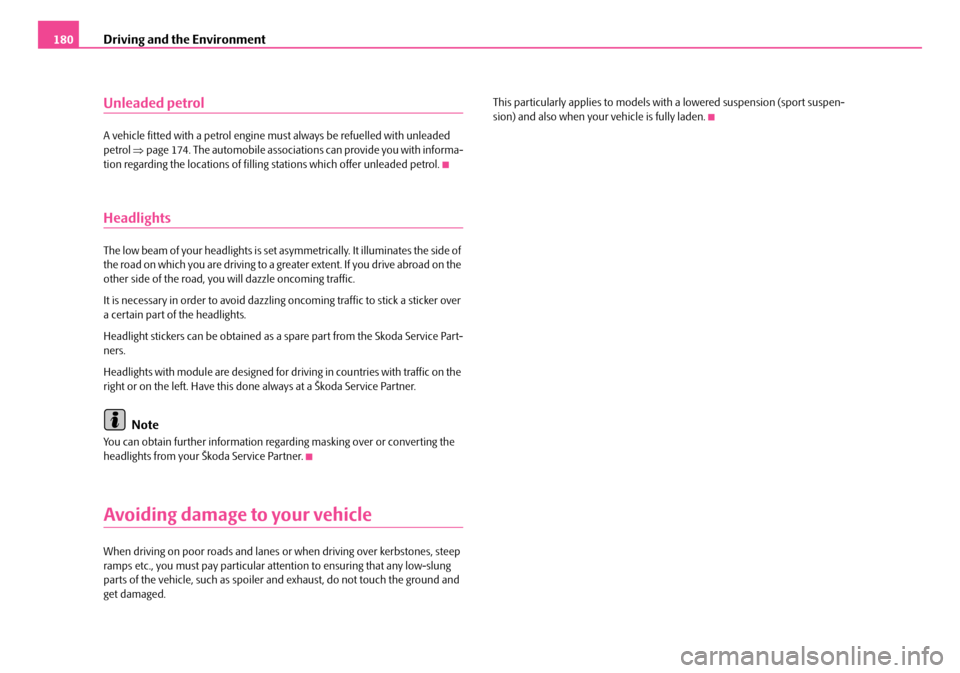
Driving and the Environment180
Unleaded petrol
A vehicle fitted with a petrol engine must always be refuelled with unleaded petrol ⇒page 174. The automobile associations can provide you with informa- tion regarding the locations of fillin g stations which offer unleaded petrol.
Headlights
The low beam of your headlights is set asymmetrically. It illuminates the side of the road on which you are driving to a gr eater extent. If you drive abroad on the other side of the road, you will dazzle oncoming traffic.
It is necessary in order to avoid dazzling oncoming traffic to stick a sticker over a certain part of the headlights.
Headlight stickers can be obtained as a spare part from the Skoda Service Part- ners.
Headlights with module are designed for dr iving in countries with traffic on the right or on the left. Have this done always at a Škoda Service Partner.
Note
You can obtain further information rega rding masking over or converting the headlights from your Škoda Service Partner.
Avoiding damage to your vehicle
When driving on poor roads and lanes or when driving over kerbstones, steep ramps etc., you must pay particular atte ntion to ensuring that any low-slung parts of the vehicle, such as spoiler an d exhaust, do not touch the ground and get damaged.
This particularly applies to models with a lowered suspension (sport suspen- sion) and also when your vehicle is fully laden.
NKO A05Fabia 20.book Page 180 Tuesday, September 26, 2006 8:38 AM
Page 182 of 258

Towing a trailer181
Using the systemSafetyDriving TipsGeneral MaintenanceBreakdown assistanceTechnical Data
Towing a trailer
Towing a trailer
Technical requirements
The towing device must satisfy certain technical requirements.
Your vehicle is designed primarily for transporting persons and luggage. It can, however, also be used fo r towing a trailer - provided certain technical equip- ment is fitted.
If your vehicle has alread y been supplied with a factory-fitted towing device then everything that is necessary for towi ng a trailer in technical terms, and in terms of the law, has already been taken into account.
Your vehicle is fitted with a 13-pin powe r socket for the electrical connection between the vehicle and trailer. If the trailer which you wish to tow has a 7-pin connector , you can use a suitable adapter 4) from Škoda original accessories.
This work must be carried out in accordance with the manufacturer's specifica- tions if a towing device is retrofitted.
Škoda Service Partners are familiar with de tails relating to retrofitting a towing device and for any necessary modifications to the cooling system.
WARNING
We recommend that you have the towing device from Škoda original accessories installed by a Škoda Servic e Partner. He is familiar with all the relevant details relating to retrofit ting such equipment. There is a risk of an accident if the towing device is not properly fitted!
General Maintenance
There are a number of points to pay attention to when towing
a trailer.
Tr a i l e r l o a d
The permissible trailer load must on no account be exceeded.
You can negotiate appropriat ely steeper inclines and descents if you do not make full use of the pe rmissible trailer load.
The trailer loads specified only apply for altitudes up to 1 000 metres above mean sea level. The fact that the engi ne power output drops with increasing he ig ht due to a low ering of a ir pres sure and thus the ability to climb, means that the towed weight must be reduced by 10 % for every further increase of 1 000 metres in height above sea level. The towed weight is the weight of the (laden) vehicle and the (laden) trailer together. One should take this into account before driving up to higher altitudes.
The trailer and drawbar load informatio n on the type plate of the towing device are merely test data for the towi ng device The data relating to your vehicle, which is often less than this test data, can be found in your vehicle registration documents or in the brochure - Technical Data .
Distribution of the load
Distribute the load in the trailer in such a way that any heavy items are located as close as possible to the axle. Secu re the items to prevent them slipping.
Tyre pressure
Correct the tyre inflation pressure on yo ur vehicle for that of “fully laden”, ⇒ page 214. The inflation pressure of the tyres fitted to the trailer adjust in accordance with the manufacturer's recommendation.
4)In some countries the adapter is supplied with the towing device.
NKO A05Fabia 20.book Page 181 Tuesday, September 26, 2006 8:38 AM
Page 183 of 258
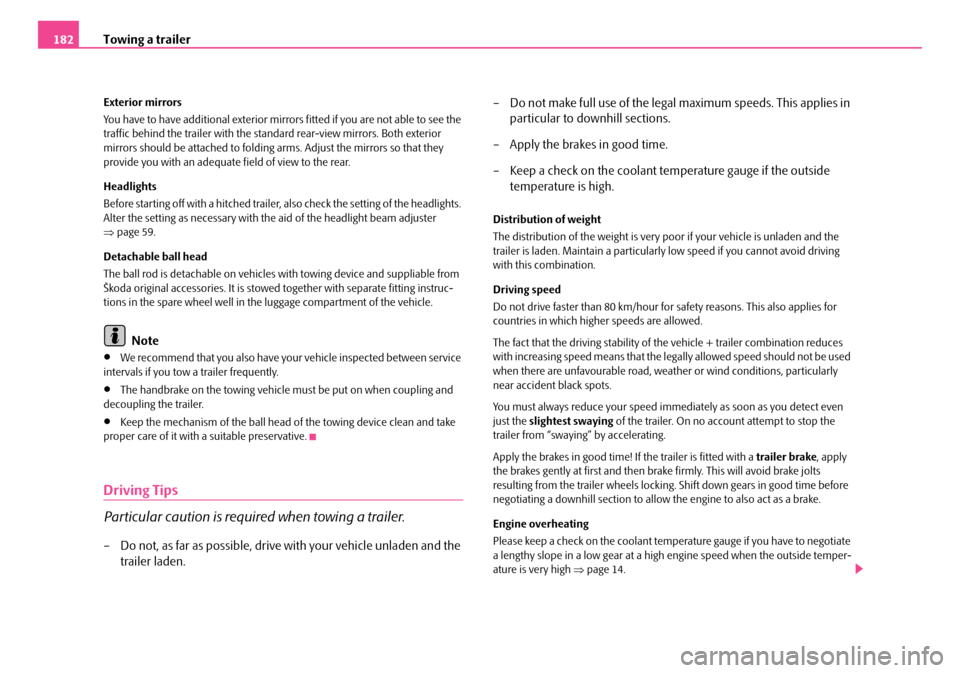
Towing a trailer182
Exterior mirrors
You have to have addi tional exterior mirrors fitted if you are not able to see the traffic behind the trailer with the standard rear-view mirrors. Both exterior mirrors should be attached to folding arms. Adjust the mirrors so that they provide you with an adequate field of view to the rear.
Headlights
Before starting off with a hitched trailer, also check the setting of the headlights. Alter the setting as necessary with th e aid of the headlight beam adjuster ⇒ page 59.
Detachable ball head
The ball rod is detachable on vehicles with towing device and suppliable from Škoda original accessories. It is stowed together with separate fitting instruc- tions in the spare wheel well in the luggage compartment of the vehicle.
Note
•We recommend that you also have yo ur vehicle inspected between service intervals if you tow a trailer frequently.
•The handbrake on the towing vehicle must be put on when coupling and decoupling the trailer.
•Keep the mechanism of the ball head of the towing device clean and take proper care of it with a suitable preservative.
Driving Tips
Particular caution is required when towing a trailer.
– Do not, as far as possible, drive with your vehicle unladen and the
trailer laden.
– Do not make full use of the lega l maximum speeds. This applies in
particular to downhill sections.
– Apply the brakes in good time.
– Keep a check on the coolant temperature gauge if the outside
temperature is high.
Distribution of weight
The distribution of the weight is very poor if your vehicle is unladen and the trailer is laden. Maintain a particularly low speed if you cannot avoid driving with this combination.
Driving speed
Do not drive faster than 80 km/hour for safety reasons. This also applies for countries in which higher speeds are allowed.
The fact that the driving stability of the vehicle + trailer combination reduces with increasing speed means that the legally allowed speed should not be used when there are unfavourable road, weat her or wind conditions, particularly near accident black spots.
You must always reduce your speed imme diately as soon as you detect even just the slightest swaying of the trailer. On no account attempt to stop the trailer from “swaying ” by accelerating.
Apply the brakes in good time! If the trailer is fitted with a trailer brake, apply the brakes gently at first and then brake firmly. This will avoid brake jolts resulting from the trailer wheels locking. Shift down gears in good time before negotiating a downhill section to allow the engine to also act as a brake.
Engine overheating
Please keep a check on the coolant temperature gauge if you have to negotiate a lengthy slope in a low gear at a high engine speed when the outside temper- ature is very high ⇒page 14.
NKO A05Fabia 20.book Page 182 Tuesday, September 26, 2006 8:38 AM
Page 184 of 258
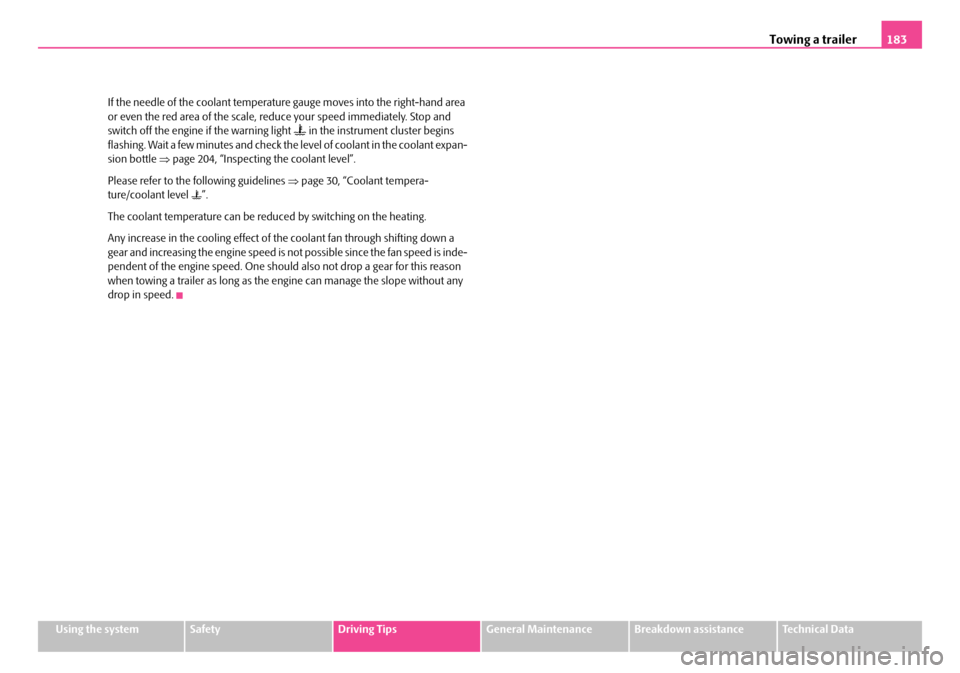
Towing a trailer183
Using the systemSafetyDriving TipsGeneral MaintenanceBreakdown assistanceTechnical Data
If the needle of the coolant temperatur e gauge moves into the right-hand area or even the red area of the scale, reduce your speed immediately. Stop and switch off the engine if the warning light in the instrument cluster begins flashing. Wait a few minutes and check th e level of coolant in the coolant expan- sion bottle ⇒page 204, “Inspecting the coolant level”.
Please refer to the following guidelines ⇒page 30, “Coolant tempera- ture/coolant level ”.
The coolant temperature can be reduced by switching on the heating.
Any increase in the cooling effect of the coolant fan through shifting down a gear and increasing the engine speed is not possible since the fan speed is inde- pendent of the engine speed. One should also not drop a gear for this reason when towing a trailer as long as the engine can manage the slope without any drop in speed.
NKO A05Fabia 20.book Page 183 Tuesday, September 26, 2006 8:38 AM
Page 185 of 258

Towing a trailer184
NKO A05Fabia 20.book Page 184 Tuesday, September 26, 2006 8:38 AM
Page 186 of 258
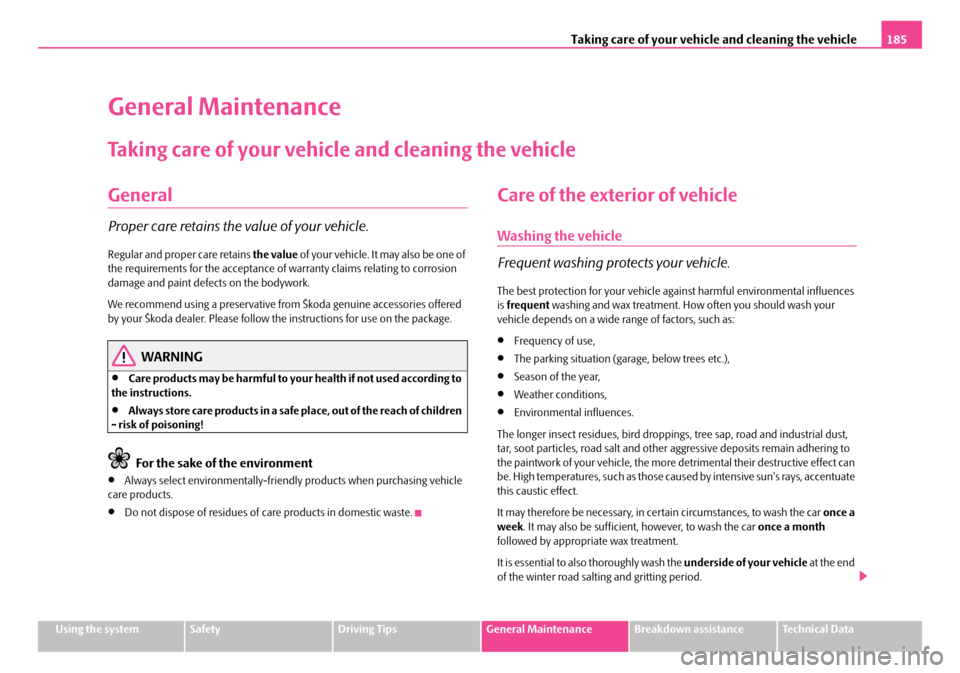
Taking care of your vehicle and cleaning the vehicle185
Using the systemSafetyDriving TipsGeneral MaintenanceBreakdown assistanceTechnical Data
General Maintenance
Taking care of your vehicle and cleaning the vehicle
General
Proper care retains the value of your vehicle.
Regular and proper care retains the value of your vehicle. It may also be one of the requirements for the acceptance of warranty claims relating to corrosion damage and paint defects on the bodywork.
We recommend using a preservative fr om Škoda genuine accessories offered by your Škoda dealer. Please follow th e instructions for use on the package.
WARNING
•Care products may be harmful to your health if not used according to the instructions.
•Always store care products in a safe place, out of the reach of children - risk of poisoning!
For the sake of the environment
•Always select environmen tally-friendly products when purchasing vehicle care products.
•Do not dispose of residues of care products in domestic waste.
Care of the exterior of vehicle
Washing the vehicle
Frequent washing protects your vehicle.
The best protection for your vehicle ag ainst harmful environmental influences is frequent washing and wax treatment. How often you should wash your vehicle depends on a wide range of factors, such as:
•Frequency of use,
•The parking situation (garage, below trees etc.),
•Season of the year,
•Weather conditions,
•Environmental influences.
The longer insect residues, bird dropping s, tree sap, road and industrial dust, tar, soot particles, road salt and other aggressive deposits remain adhering to the paintwork of your vehicle, the more detrimental their destructive effect can be. High temperatures, such as those caus ed by intensive sun's rays, accentuate this caustic effect.
It may therefore be necessary, in ce rtain circumstances, to wash the car once a week . It may also be sufficient, however, to wash the car once a month followed by approp riate wax treatment.
It is essential to also thoroughly wash the underside of your vehicle at the end of the winter road salting and gritting period.
NKO A05Fabia 20.book Page 185 Tuesday, September 26, 2006 8:38 AM
Page 187 of 258
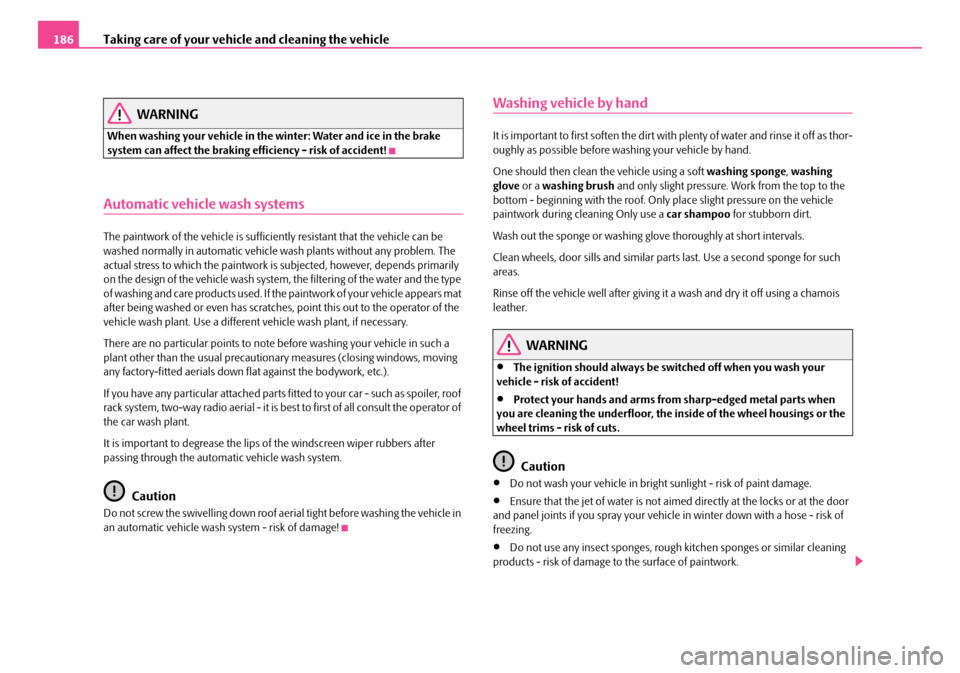
Taking care of your vehicle and cleaning the vehicle186
WARNING
When washing your vehicle in the winter: Water and ice in the brake system can affect the braking ef ficiency - risk of accident!
Automatic vehicle wash systems
The paintwork of the vehicle is sufficiently resistant that the vehicle can be washed normally in automa tic vehicle wash plants without any problem. The actual stress to which the paintwork is subjected, however, depends primarily on the design of the vehicle wash system, the filtering of the water and the type of washing and care products used. If th e paintwork of your vehicle appears mat after being washed or even has scratches, point this out to the operator of the vehicle wash plant. Use a different vehicle wash plant, if necessary.
There are no particular points to note before washing your vehicle in such a plant other than the usual precautionar y measures (closing windows, moving any factory-fitted aerials down flat against the bodywork, etc.).
If you have any particular attached parts fi tted to your car - such as spoiler, roof rack system, two-way radio aerial - it is be st to first of all consult the operator of the car wash plant.
It is important to degrease the lips of the windscreen wiper rubbers after passing through the automatic vehicle wash system.
Caution
Do not screw the swivelling down roof ae rial tight before washing the vehicle in an automatic vehicle wash system - risk of damage!
Washing vehicle by hand
It is important to first soften the dirt with plenty of water and rinse it off as thor- oughly as possible before wa shing your vehicle by hand.
One should then clean the vehicle using a soft washing sponge, washing glove or a washing brush and only slight pressure. Work from the top to the bottom - beginning with the roof. Only place slight pressure on the vehicle paintwork during cl eaning Only use a car shampoo for stubborn dirt.
Wash out the sponge or washing glove thoroughly at short intervals.
Clean wheels, door sills and similar parts last. Use a second sponge for such areas.
Rinse off the vehicle well after giving it a wash and dry it off using a chamois leather.
WARNING
•The ignition should always be switched off when you wash your vehicle - risk of accident!
•Protect your hands and arms from sharp-edged metal parts when you are cleaning the underfloor, the in side of the wheel housings or the wheel trims - risk of cuts.
Caution
•Do not wash your vehicl e in bright sunlight - risk of paint damage.
•Ensure that the jet of water is not aimed directly at the locks or at the door and panel joints if you spray your vehicle in winter down with a hose - risk of freezing.
•Do not use any insect sponges, rough kitchen sponges or similar cleaning products - risk of damage to the surface of paintwork.
NKO A05Fabia 20.book Page 186 Tuesday, September 26, 2006 8:38 AM
Page 188 of 258
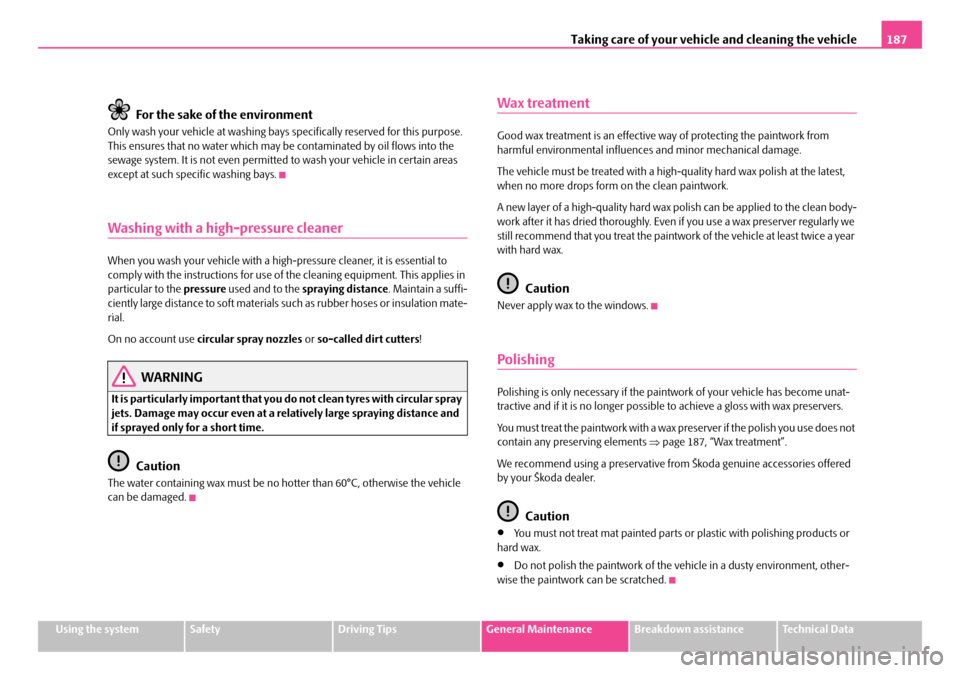
Taking care of your vehicle and cleaning the vehicle187
Using the systemSafetyDriving TipsGeneral MaintenanceBreakdown assistanceTechnical Data
For the sake of the environment
Only wash your vehicle at washing bays specifically reserved for this purpose. This ensures that no water which may be contaminated by oil flows into the sewage system. It is not even permitted to wash your vehicle in certain areas except at such specific washing bays.
Washing with a high-pressure cleaner
When you wash your vehicle with a high -pressure cleaner, it is essential to comply with the instructions for use of the cleaning equipment. This applies in particular to the pressure used and to the spraying distance. Maintain a suffi- ciently large distance to soft materials su ch as rubber hoses or insulation mate- rial.
On no account use circular spray nozzles or so-called dirt cutters!
WARNING
It is particularly important that you do not clean tyres with circular spray jets. Damage may occur even at a rela tively large spraying distance and if sprayed only for a short time.
Caution
The water containing wax must be no hotter than 60°C, otherwise the vehicle can be damaged.
Wax treatment
Good wax treatment is an effective wa y of protecting the paintwork from harmful environmental influences and minor mechanical damage.
The vehicle must be treated with a high-q uality hard wax polish at the latest, when no more drops form on the clean paintwork.
A new layer of a high-quality hard wax po lish can be applied to the clean body- work after it has dried thoroughly. Even if you use a wax preserver regularly we still recommend that you treat the paintwork of the vehicle at least twice a year with hard wax.
Caution
Never apply wax to the windows.
Polishing
Polishing is only necessary if the paintwork of your vehicle has become unat-tractive and if it is no longer possibl e to achieve a gloss with wax preservers.
You must treat the paintwork with a wax preserver if the polish you use does not contain any preserving elements ⇒page 187, “Wax treatment”.
We recommend using a preservative fr om Škoda genuine accessories offered by your Škoda dealer.
Caution
•You must not treat mat painted parts or plastic with polishing products or hard wax.
•Do not polish the paintwork of the ve hicle in a dusty environment, other- wise the paintwork can be scratched.
NKO A05Fabia 20.book Page 187 Tuesday, September 26, 2006 8:38 AM
Page 189 of 258
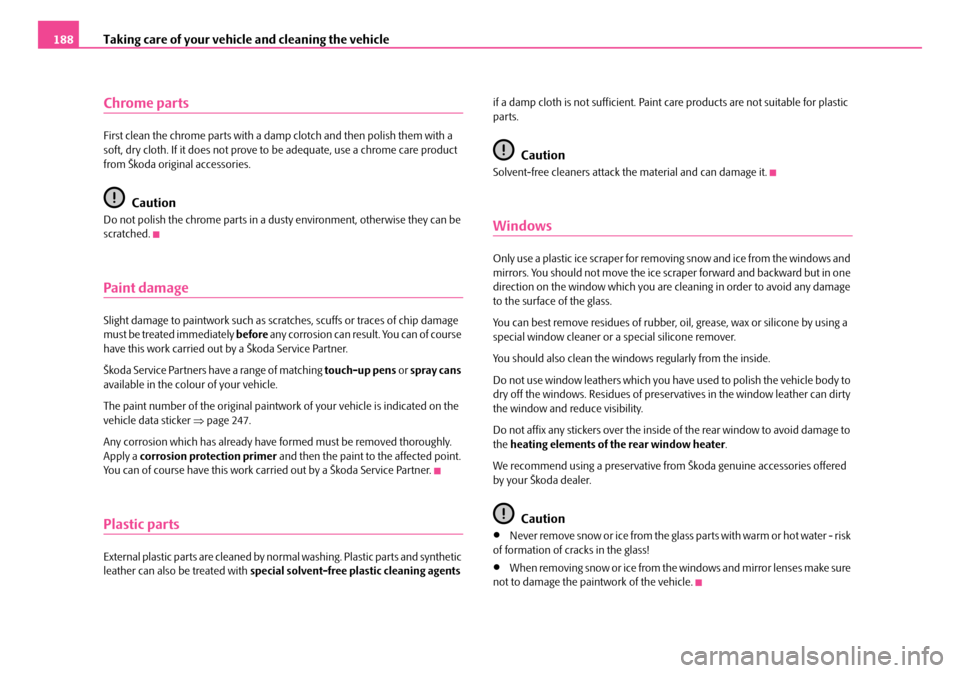
Taking care of your vehicle and cleaning the vehicle188
Chrome parts
First clean the chrome parts with a damp clotch and then polish them with a soft, dry cloth. If it does not prove to be adequate, use a chrome care product from Škoda original accessories.
Caution
Do not polish the chrome parts in a du sty environment, otherwise they can be scratched.
Paint damage
Slight damage to paintwork such as scratches, scuffs or traces of chip damage must be treated immediately before any corrosion can result. You can of course have this work carried out by a Škoda Service Partner.
Škoda Service Partners ha ve a range of matching touch-up pens or spray cans available in the colour of your vehicle.
The paint number of the orig inal paintwork of your vehicle is indicated on the vehicle data sticker ⇒page 247.
Any corrosion which has already have formed must be removed thoroughly. Apply a corrosion protection primer and then the paint to the affected point. You can of course have this work carried out by a Škoda Service Partner.
Plastic parts
External plastic parts are cleaned by norm al washing. Plastic parts and synthetic leather can also be treated with special solvent-free plastic cleaning agents
if a damp cloth is not sufficient. Paint care products are not suitable for plastic parts.
Caution
Solvent-free cleaners attack th e material and can damage it.
Windows
Only use a plastic ice scraper for removing snow and ice from the windows and mirrors. You should not move the ice scraper forward and backward but in one direction on the window which you are cl eaning in order to avoid any damage to the surface of the glass.
You can best remove residues of rubber, oil, grease, wax or silicone by using a special window cleaner or a special silicone remover.
You should also clean the windows regularly from the inside.
Do not use window leathers which you have used to polish the vehicle body to dry off the windows. Residues of preservatives in the window leather can dirty the window and reduce visibility.
Do not affix any stickers over the inside of the rear window to avoid damage to the heating elements of the rear window heater.
We recommend using a preservative fr om Škoda genuine accessories offered by your Škoda dealer.
Caution
•Never remove snow or ice from the glass parts with warm or hot water - risk of formation of cracks in the glass!
•When removing snow or ice from the windows and mirror lenses make sure not to damage the paintwork of the vehicle.
NKO A05Fabia 20.book Page 188 Tuesday, September 26, 2006 8:38 AM
Page 190 of 258
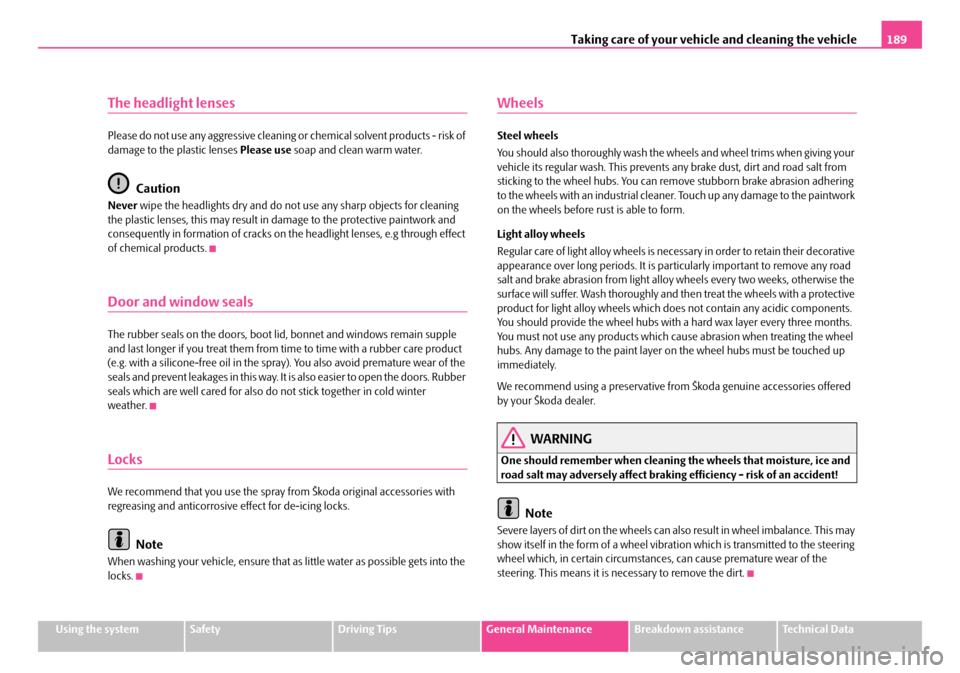
Taking care of your vehicle and cleaning the vehicle189
Using the systemSafetyDriving TipsGeneral MaintenanceBreakdown assistanceTechnical Data
The headlight lenses
Please do not use any aggressive cleaning or chemical solvent products - risk of damage to the plastic lenses Please use soap and clean warm water.
Caution
Never wipe the headlights dry and do not use any sharp objects for cleaning the plastic lenses, this may result in da mage to the protective paintwork and consequently in formation of cracks on the headlight lenses, e.g through effect of chemical products.
Door and window seals
The rubber seals on the doors, boot lid, bonnet and windows remain supple and last longer if you trea t them from time to time with a rubber care product (e.g. with a silicone-free oil in the spray). You also avoid premature wear of the seals and prevent leakages in this way. It is also easier to open the doors. Rubber seals which are well cared for also do not stick together in cold winter weather.
Locks
We recommend that you use the spray fr om Škoda original accessories with regreasing and anticorrosive effect for de-icing locks.
Note
When washing your vehicle, ensure that as little water as possible gets into the locks.
Wheels
Steel wheels
You should also thoroughly wash the wheels and wheel trims when giving your vehicle its regular wash. This prevents an y brake dust, dirt and road salt from sticking to the wheel hubs. You can remo ve stubborn brake abrasion adhering to the wheels with an industrial cleane r. Touch up any damage to the paintwork on the wheels before rust is able to form.
Light alloy wheels
Regular care of light alloy wheels is necessary in order to retain their decorative appearance over long periods. It is particularly important to remove any road salt and brake abrasion from light alloy wheels every two weeks, otherwise the surface will suffer. Wash thoroughly and th en treat the wheels with a protective product for light alloy wheels which does not contain any acidic components. You should provide the wheel hubs with a hard wax layer every three months. You must not use any products which ca use abrasion when treating the wheel hubs. Any damage to the paint layer on the wheel hubs must be touched up immediately.
We recommend using a preservative fr om Škoda genuine accessories offered by your Škoda dealer.
WARNING
One should remember when cleaning the wheels that moisture, ice and road salt may adversely affect brakin g efficiency - risk of an accident!
Note
Severe layers of dirt on the wheels can also result in wheel imbalance. This may show itself in the form of a wheel vibrat ion which is transmitted to the steering wheel which, in certain circumstance s, can cause premature wear of the steering. This means it is necessary to remove the dirt.
NKO A05Fabia 20.book Page 189 Tuesday, September 26, 2006 8:38 AM